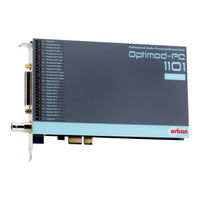Orban Optimod-PC 1101 Manuals
Manuals and User Guides for Orban Optimod-PC 1101. We have 1 Orban Optimod-PC 1101 manual available for free PDF download: Operating Manual
Orban Optimod-PC 1101 Operating Manual (258 pages)
Digital Audio Processor PCI Sound Card
Brand: Orban
|
Category: Sound Card
|
Size: 3 MB
Table of Contents
Advertisement
